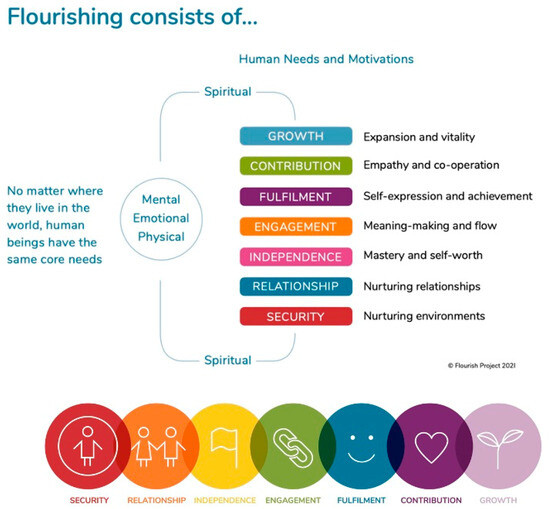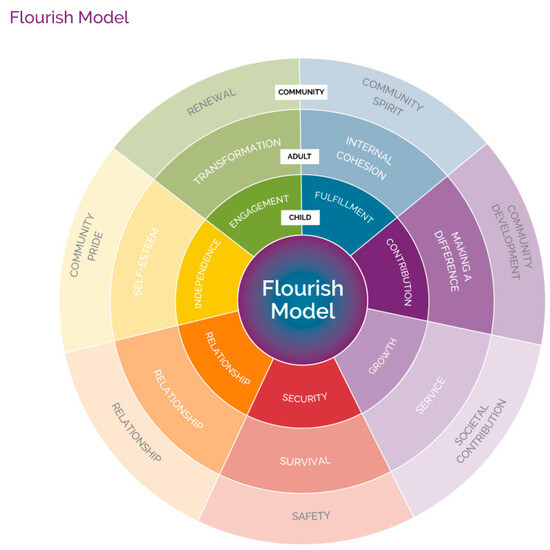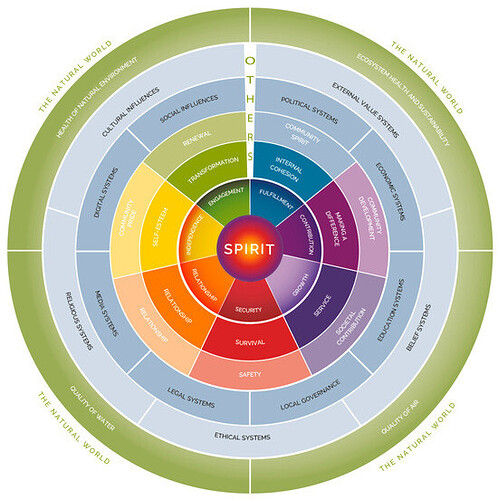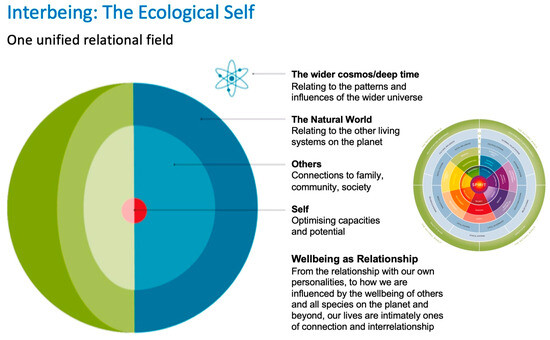Hiya, here is a comparison that I started working on (in order to get this clearer in my own head  )
)
ESF - Evolving Ken Wilber’s AQAL Framework - draft text March 2025.docx (24.8 KB)
Inlined
Eco-Systemic Flourishing: Evolving Ken Wilber’s AQAL Framework for a Planetary Age
Wendy Ellyatt, Working doc, March 2025
This document explores how the Eco-Systemic Flourishing (ESF) framework builds upon and evolves Ken Wilber’s AQAL (All Quadrants, All Levels) model to meet the urgent needs of the 21st century. While AQAL revolutionized systems thinking by integrating interior and exterior, individual and collective dimensions of reality, it underemphasized the centrality of ecological relationality and planetary agency, something that has been picked up by a number of contemporary researchers. The ESF framework addresses this gap by embedding human flourishing explicitly within ecological systems, treating the natural world as a living, participatory domain rather than merely a backdrop for human development. This evolution hopes to offer a more holistic, regenerative model for education, governance, and global civic flourishing.
Introduction
Ken Wilber’s AQAL model has significantly influenced integral theory, systems thinking, and developmental psychology by offering a map that integrates subjective, objective, intersubjective, and interobjective dimensions of reality. However, emerging critiques from ecological philosophy, indigenous scholarship, and integral ecology suggest that AQAL, while groundbreaking, remains subtly anthropocentric. The natural world, while acknowledged, is treated primarily as an ‘exterior-collective’ context rather than as an active participant in co-evolutionary processes.
The Eco-Systemic Flourishing (ESF) framework emerges as a next-generation evolution, retaining AQAL’s structural integrity while re-centering planetary health, relational consciousness, and ecological agency. This paper outlines how ESF extends AQAL’s insights to better serve an age of climate emergency, biodiversity collapse, and the urgent need for regenerative cultures.
Comparative Overview: AQAL and ESF
|
|
|
| Dimension |
AQAL Model |
ESF Framework |
| Structural Integration |
Four quadrants: Interior/Exterior, Individual/Collective |
Four domains: Natural Environment, Regenerative Economies. Cultural Values, Human Potential, |
| Human Development |
Central focus on stages of consciousness and self-actualization |
Focus on dynamic flourishing within planetary and relational systems |
| Nature and Ecology |
Treated as system (LR quadrant) |
Treated as living participant; ecological embeddedness as foundation |
| Spiritual Dimension |
Emphasized through interior quadrants |
Integrated across all domains, including ecological reverence |
| Agency and Relationality |
Primarily human-centered |
Co-agency of humans, communities, ecosystems, and the planet |
Wilber’s View on the Evolution of Consciousness
Ken Wilber’s model of consciousness evolution can be summarized in these major themes:
a. Developmental Stages
Wilber argues that individual and collective consciousness evolves through structured stages — much like cognitive, moral, or psychosocial development theories (e.g., Piaget, Kohlberg, Graves, Barret).
Typical stages (simplified) are:
- Egocentric (self-only awareness)
- Ethnocentric (tribe/nation-based identity)
- Worldcentric (universal human rights, global ethics)
- Kosmocentric (all beings, ecosystems, and even the cosmos are valued)
Each stage transcends and includes the previous, meaning greater depth and breadth of care, awareness, and identity.
b. Lines of Development
Wilber emphasizes multiple intelligences or lines of growth:
e.g., cognitive, emotional, aesthetic, moral, spiritual)
One can be cognitively advanced but morally immature, for example.
c. States vs. Stages
Wilber also distinguishes between:
- States of consciousness (temporary experiences, e.g., mystical experiences, peak states)
- Stages of consciousness (permanent developmental shifts that rewire identity and perception).
d. Spiral Dynamics and Integral Psychology
Wilber integrates the Spiral Dynamics of Beck & Cowan — a model showing color-coded value systems (e.g., Beige survivalism → Green pluralism → Yellow systemic thinking → Turquoise holistic consciousness) to track societal and consciousness evolution.
How ESF Would Frame Consciousness Evolution
|
|
| Wilberian View |
ESF Evolutionary Lens
|
| Move from ethnocentric to worldcentric consciousness |
Deepen into earthcentric and ecosystemic consciousness |
| Expand self-identity to global humanism |
Expand self-identity to include Earth as Self |
| Access transpersonal states |
Embody regenerative/mindful relational practices daily |
| Cultivate interior wisdom |
Integrate inner flourishing with active planetary stewardship |
Key Evolutions Introduced by ESF
1. Planetary Embeddedness ESF explicitly nests human flourishing within ecological systems. It recognizes that the vitality of ecosystems is not a peripheral concern but foundational to human, cultural, and systemic thriving.
2. Ecological Agency Where AQAL tends to map the natural world as ‘background’, ESF elevates ecological systems as dynamic, participatory agents. Ecosystems, species, and living systems are co-creators of flourishing futures.
3. Relational Spirituality While AQAL explores spiritual development through stages, ESF integrates spiritual reverence for life throughout its domains—recognizing awe, gratitude, and ecological empathy as central capacities for flourishing.
4. Regenerative Systems Thinking ESF moves beyond sustainability toward regeneration. It aligns with circular economies, biomimicry, and indigenous wisdom traditions that prioritize the renewal and thriving of all life systems.
5. Cultural and Pluralistic Sensitivity Where AQAL provided a meta-framework applicable across cultures, ESF further deepens this by valuing Indigenous, place-based, and ecological epistemologies as essential to a full-spectrum model of development.
Implications for Global Flourishing
In an era defined by ecological collapse and rising social fragmentation, frameworks for transformation must fully embrace planetary consciousness. The ESF framework offers a further evolution of integral thinking, proposing that any authentic model of human development must be simultaneously:
- Individually transformative
- Culturally regenerative
- Systemically redesigning
- Ecologically embedded
Through its dynamic integration of human, cultural, systemic, and ecological dimensions, ESF aligns closely with emerging movements such as the Global Flourishing Goals, Inner Development Goals, and regenerative education initiatives.
Conclusion
The Eco-Systemic Flourishing framework honors and extends Ken Wilber’s pioneering AQAL model. By re-centering ecological embeddedness, honoring non-human agency, and weaving relational spirituality throughout its structure, ESF responds to the complexities of the 21st century with the depth and dynamism they demand. As humanity faces an unprecedented planetary turning point, integrative frameworks like ESF offer not only a new map but a new way of inhabiting and co-flourishing with the Earth.
![]()



